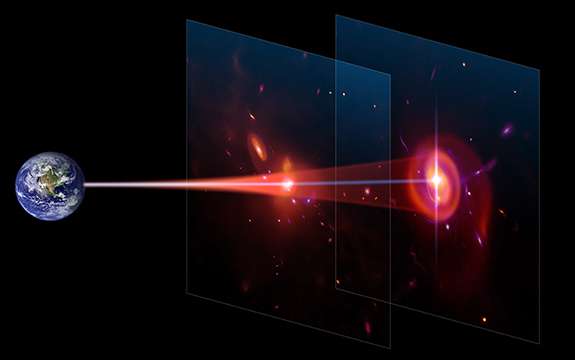New method solves 40 year-old mystery on the size of shadowy galaxies

Using the world's largest telescopes, researchers have discovered ancient cold gas clouds larger than galaxies in the early Universe. The discovery was announced today at a press conference at the 227th meeting of the American Astronomical Society in Orlando, Florida.
The discovery, led by Associate Professor Jeff Cooke, Swinburne University of Technology, and Associate Professor John O'Meara, St. Michael's College, has helped solve a decades-old puzzle on the nature of gas clouds, known as damped Lyman alpha systems, or DLAs.
Cooke and O'Meara realised that finding DLA gas clouds in the line of sight to background galaxies would enable measurements of their size by determining how much of the galaxy they cover.
"Our new method first identifies galaxies that are more likely to have intervening DLA gas clouds and then searches for them using long, deep exposures on the powerful Keck Observatory 10m telescopes in Hawaii and deep data from the VLT 8m telescopes in Chile," says Associate Professor Cooke.
"The technique is timely as the next generation of giant 30m telescopes will be online in several years and are ideal to exploit this method to routinely gather large numbers of DLAs for study."
DLA clouds contain most of the cool gas in the Universe and are predicted to contain enough gas to form most of the stars we see in galaxies around us today, like the Milky Way. However, this prediction has yet to be confirmed.
DLAs currently have little ongoing star formation, making them too dim to observe directly from their emitted light alone. Instead, they are detected when they happen to fall in the line of sight to a more distant bright object and leave an unmistakeable absorption signature in the background object's light.
Previously, researchers used quasars as the background objects to search for DLAs. Although quasars can be very bright, they are rare and are comparatively small, only a fraction of a light year across, whereas galaxies are quite common and provide a 100 million-fold increase in area to probe DLAs.
"Using the galaxy technique, DLAs can be studied in large numbers to provide a 3-D tomographic picture of distribution of gas clouds in the early Universe and help complete our understanding of how galaxies formed and evolved over cosmic time," says Associate Professor O'Meara.
More information: J. Cooke et al. A New Constraint on the Physical Nature of Damped Lyman Alpha Systems, The Astrophysical Journal (2015). DOI: 10.1088/2041-8205/812/2/L27
Journal information: Astrophysical Journal
Provided by Swinburne University of Technology




















